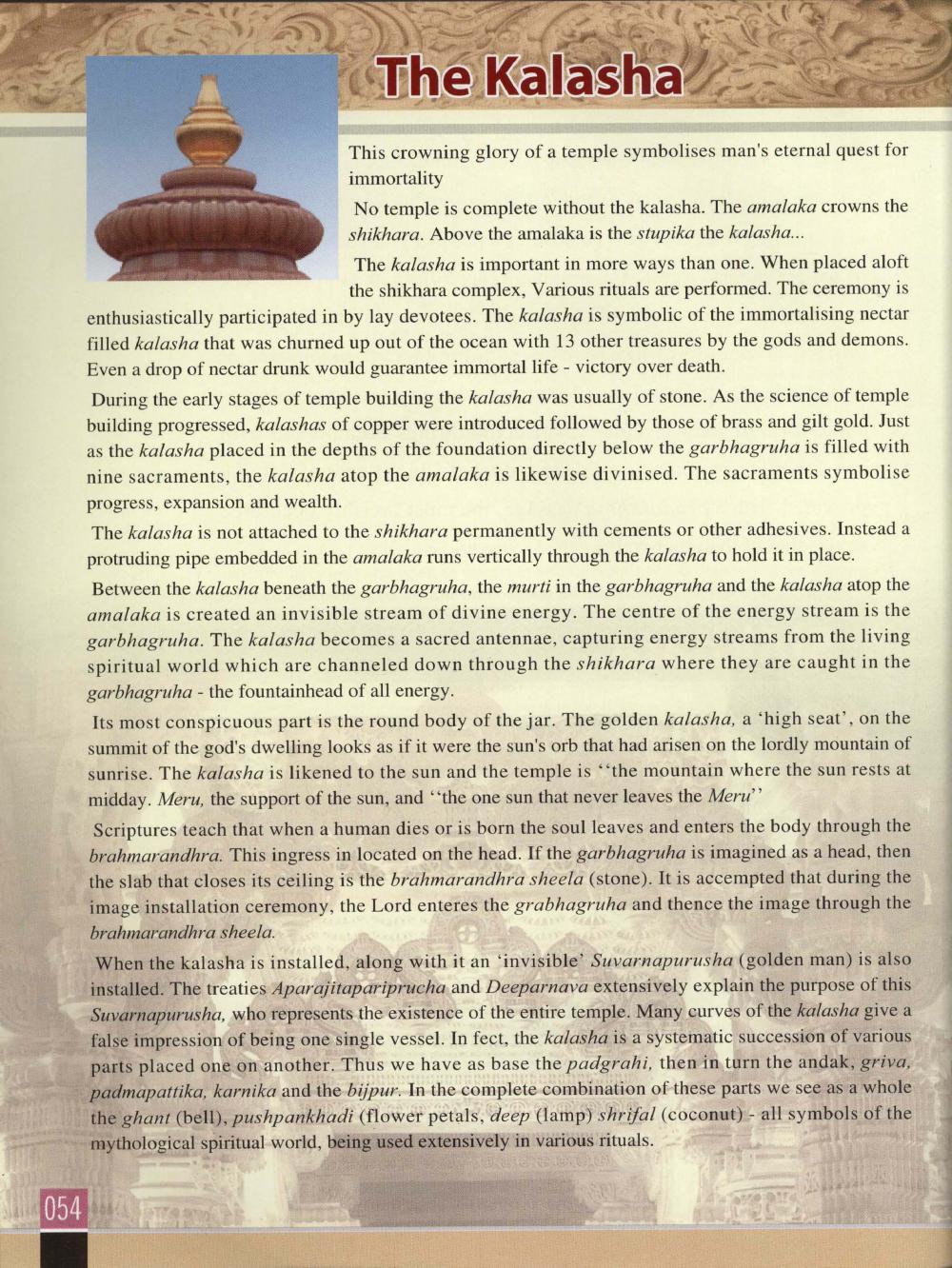________________
054
The Kalasha
This crowning glory of a temple symbolises man's eternal quest for immortality
No temple is complete without the kalasha. The amalaka crowns the shikhara. Above the amalaka is the stupika the kalasha....
The kalasha is important in more ways than one. When placed aloft the shikhara complex, Various rituals are performed. The ceremony is enthusiastically participated in by lay devotees. The kalasha is symbolic of the immortalising nectar filled kalasha that was churned up out of the ocean with 13 other treasures by the gods and demons. Even a drop of nectar drunk would guarantee immortal life - victory over death.
During the early stages of temple building the kalasha was usually of stone. As the science of temple building progressed, kalashas of copper were introduced followed by those of brass and gilt gold. Just as the kalasha placed in the depths of the foundation directly below the garbhagruha is filled with nine sacraments, the kalasha atop the amalaka is likewise divinised. The sacraments symbolise progress, expansion and wealth.
The kalasha is not attached to the shikhara permanently with cements or other adhesives. Instead a protruding pipe embedded in the amalaka runs vertically through the kalasha to hold it in place.
Between the kalasha beneath the garbhagruha, the murti in the garbhagruha and the kalasha atop the amalaka is created an invisible stream of divine energy. The centre of the energy stream is the garbhagruha. The kalasha becomes a sacred antennae, capturing energy streams from the living spiritual world which are channeled down through the shikhara where they are caught in the garbhagruha - the fountainhead of all energy.
Its most conspicuous part is the round body of the jar. The golden kalasha, a 'high seat', on the summit of the god's dwelling looks as if it were the sun's orb that had arisen on the lordly mountain of sunrise. The kalasha is likened to the sun and the temple is "the mountain where the sun rests at midday. Meru, the support of the sun, and "the one sun that never leaves the Meru"
Scriptures teach that when a human dies or is born the soul leaves and enters the body through the brahmarandhra. This ingress in located on the head. If the garbhagruha is imagined as a head, then the slab that closes its ceiling is the brahmarandhra sheela (stone). It is accempted that during the image installation ceremony, the Lord enteres the grabhagruha and thence the image through the brahmarandhra sheela,
When the kalasha is installed, along with it an 'invisible' Suvarnapurusha (golden man) is also installed. The treaties Aparajitapariprucha and Deeparnava extensively explain the purpose of this Suvarnapurusha, who represents the existence of the entire temple. Many curves of the kalasha give a false impression of being one single vessel. In fect, the kalasha is a systematic succession of various parts placed one on another. Thus we have as base the padgrahi, then in turn the andak, griva, padmapattika, karnika and the bijpur. In the complete combination of these parts we see as a whole the ghant (bell), pushpankhadi (flower petals, deep (lamp) shrifal (coconut) all symbols of the mythological spiritual world, being used extensively in various rituals.




